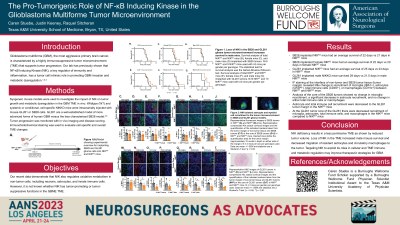The Pro-Tumorigenic Role of NF-κB Inducing Kinase in the Glioblastoma Multiforme Tumor Microenvironment
The Pro-tumorigenic Role of NF-κB Inducing Kinase in the Glioblastoma Multiforme Tumor Microenvironment
Friday, April 21, 2023


Caren Stuebe, MSc (she/her/hers)
Medical Student
Texas A&M School of Medicine
Dallas, Texas, United States
ePoster Presenter(s)
Introduction: Glioblastoma multiforme (GBM), the most aggressive primary brain cancer, is characterized by a highly immunosuppressive tumor microenvironment (TME) that supports tumor progression. Our lab has previously shown that NF-κB Inducing Kinase (NIK), a key regulator of immunity and inflammation, has a tumor cell intrinsic role in promoting GBM invasion and metabolic dysregulation. Our recent data demonstrate that NIK also regulates oxidative metabolism in non-tumor cells, including neurons, astrocytes, and innate immune cells. However, it is not known whether NIK has tumor-promoting or tumor-suppressive functions in the GBM TME.
Methods: 3D spheroid co-culture systems were used to examined how wild type (WT) versus NIK knockout (NIK-KO) astrocytes and neurons impacted GBM growth, invasion, and metabolism. Syngeneic mouse models were used to investigate the impact of NIK on tumor growth and metabolic dysregulation in the GBM TME in vivo. WT and systemic or conditional, cell-specific NIK-KO mice were intracranially injected with mouse GL261 or SB28 cells. Tumor progression was monitored with in vivo imaging and disease scoring. Immunohistochemical staining was used to evaluate cell specific and overall TME changes.
Results: In syngeneic GL261 and SB28 orthotopic mouse models of GBM, NIK-KO mice formed smaller, less vascularized intracranial tumors and had increased survival compared to WT mice. Additionally, preliminary data suggests more infiltrated immune cells in the tumor core versus the periphery in NIK-KO mice. In vitro co-culture models of control and NIK-KO astrocytes and neurons revealed deregulated growth and metabolism.
Conclusion : NIK deficiency results in a less permissive TME as shown by reduced tumor volume. Impaired functioning in immune and astrocytic/neuronal co-culture GBM models suggests NIK has pro-tumorigenic functions through regulation of metabolism at the cellular level and in the TME. Targeting NIK to exploit its roles in cellular and TME immune and metabolic regulation may improve therapeutic strategies for GBM.
Methods: 3D spheroid co-culture systems were used to examined how wild type (WT) versus NIK knockout (NIK-KO) astrocytes and neurons impacted GBM growth, invasion, and metabolism. Syngeneic mouse models were used to investigate the impact of NIK on tumor growth and metabolic dysregulation in the GBM TME in vivo. WT and systemic or conditional, cell-specific NIK-KO mice were intracranially injected with mouse GL261 or SB28 cells. Tumor progression was monitored with in vivo imaging and disease scoring. Immunohistochemical staining was used to evaluate cell specific and overall TME changes.
Results: In syngeneic GL261 and SB28 orthotopic mouse models of GBM, NIK-KO mice formed smaller, less vascularized intracranial tumors and had increased survival compared to WT mice. Additionally, preliminary data suggests more infiltrated immune cells in the tumor core versus the periphery in NIK-KO mice. In vitro co-culture models of control and NIK-KO astrocytes and neurons revealed deregulated growth and metabolism.
Conclusion : NIK deficiency results in a less permissive TME as shown by reduced tumor volume. Impaired functioning in immune and astrocytic/neuronal co-culture GBM models suggests NIK has pro-tumorigenic functions through regulation of metabolism at the cellular level and in the TME. Targeting NIK to exploit its roles in cellular and TME immune and metabolic regulation may improve therapeutic strategies for GBM.
